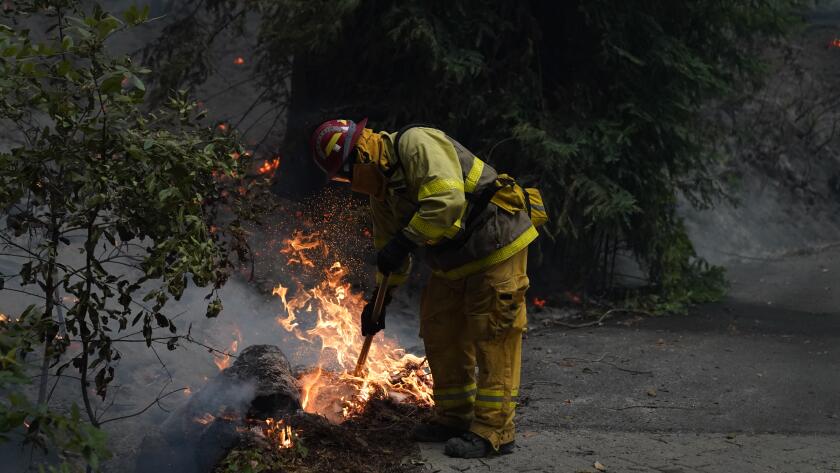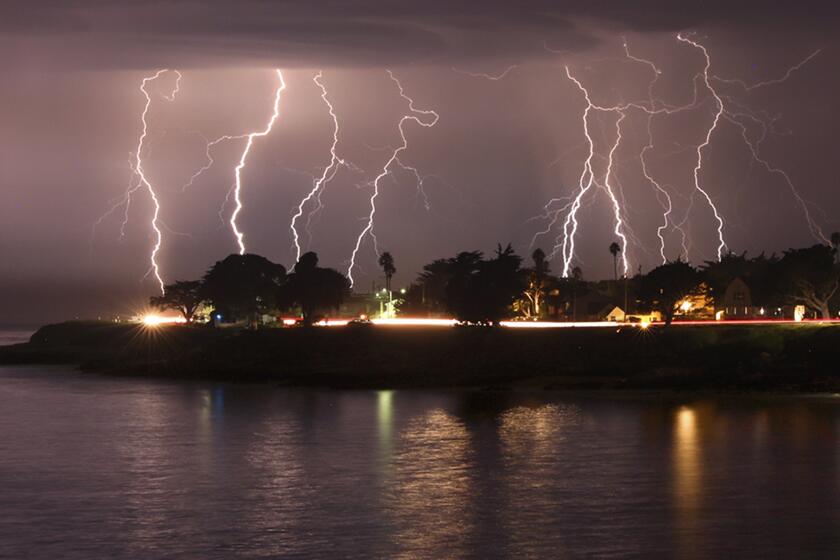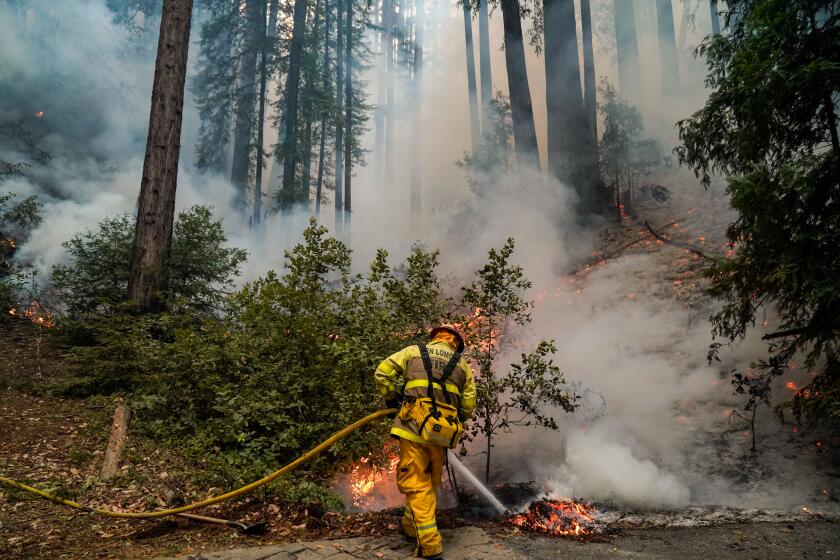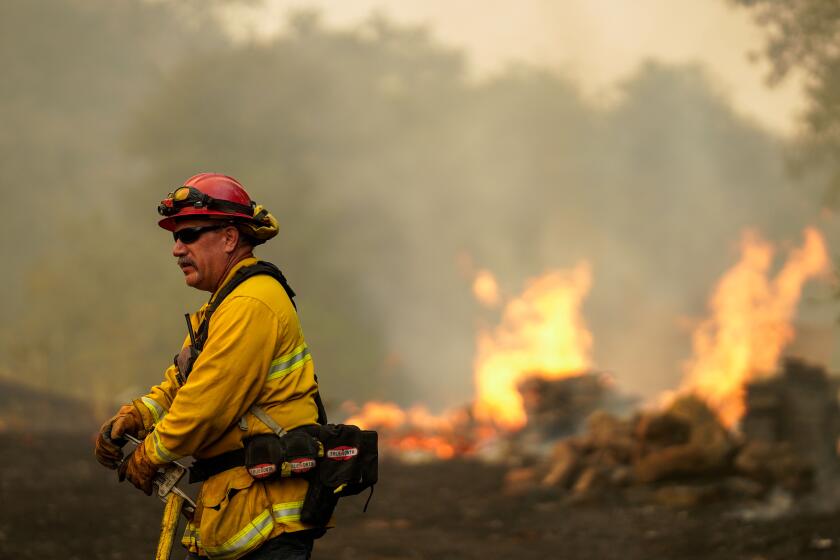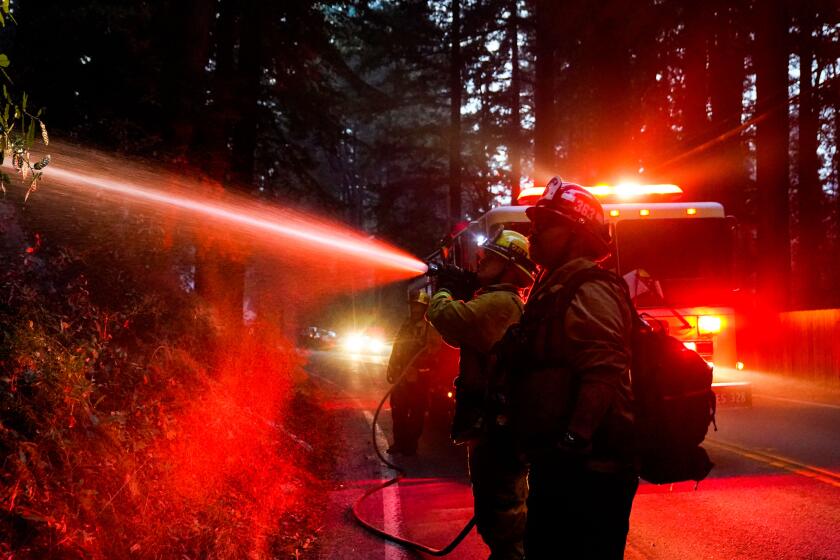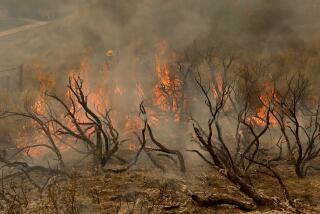Northern California fires rage on: ‘We are essentially living in a mega fire era’
The next few days will be critical for California firefighters already pushed to capacity, as storms could bring lightning that ignites more fires.
SAN FRANCISCO — As two of the three largest fires in California history burned near the eastern edge of San Jose and in wine country north of San Francisco Bay, firefighters saw a welcome respite in dangerous fire weather with the cancellation of a red-flag warning for the Bay Area.
Forecasters, however, continued to warn about dry lightning in the Sacramento Valley’s foothills and mountains through Monday evening. Red-flag warnings — which indicate that dangerous fire weather conditions are expected — were also in effect for parts of the North Coast, northeast California and the Tahoe Basin through Monday evening.
The National Weather Service initially issued warnings covering large swaths of Northern and Central California through Monday afternoon. With firefighters already responding to more than two dozen major fires, it was feared the storms could ignite even more blazes and cause existing ones to spread more rapidly, pushing crews into a triage situation.
The red-flag warning covering the Bay Area and northern Central Coast was canceled shortly after 9:30 a.m. Monday. The local National Weather Service office said that “weak cells are still over the North Bay; however, most moisture has moved north of our area and instability has decreased, giving us confidence to let the warning expire early.”
Firefighters were able to use a brief respite in the wind over the weekend to build containment lines. Crews battling the CZU Lightning Complex fire in San Mateo and Santa Cruz counties got some additional help from Mother Nature in the form of rain showers Sunday evening.
“The weather hasn’t been as significant as we were expecting, which is good,” Mark Brunton, operations chief for the California Department of Forestry and Fire Protection, said at a briefing Monday morning. “And that has given us an opportunity for our crews to make a lot of great progress throughout this fire.”
The sheer magnitude of what has already burned is sobering: about 1.4 million acres this month alone, with four more months of potential fire season to go. Only 2018 saw more land scorched in California — over an entire year.
“I’m essentially at a loss for words to describe the scope of the lightning-sparked fire outbreak that has rapidly evolved in Northern California — even in the context of the extraordinary fires of recent years,” wrote Daniel Swain, a climate scientist at UCLA, in a blog post. “It’s truly astonishing.”
Jake Hess, a Cal Fire unit chief, said at a news conference for the SCU Lightning Complex fire — now California’s second-largest blaze in history at more than 360,000 acres — that the state has entered a period of mega fires.
“We are essentially living in a mega fire era,” he said. “We have folks who have been working for Cal Fire for the last five years, and that is all they understand, mega fires, since they started.”
On Saturday, Gov. Gavin Newsom announced that the White House had approved California’s request for a presidential major disaster declaration to bolster the state’s emergency response to the wildfires.
Across California, “over 14,000 firefighters are on the front lines of more than two dozen major fires and lightning complexes,” or groups of fires, Jeremy Rahn, Cal Fire public information officer, said at a Sunday media briefing.
There have been more than 13,000 lightning strikes statewide since Aug. 15, he added on Monday, and “an astonishing 2,700 more wildfires have occurred this year than last.”
During a media briefing Monday afternoon, Newsom said that there had been at least 289 lightning strikes statewide over the last 24 hours, and that 10 new fires had broken out.
“The good news is the lightning did spare the coast, where a lot of the fires are going right now,” Michelle Mead, a meteorologist with the National Weather Service, said Monday in a Cal Fire video update. “The bad news is we did have more lightning strikes in the inland region along the Sierra Crest.”
Crews are currently battling 625 fires throughout the state, according to Newsom. So far this year, firefighters have responded to 7,002 fires that have scorched a combined 1.4 million acres, the governor said.
By this same time last year, there had been 4,292 fires that had consumed about 56,000 acres.
Seven people have died so far in this year’s fires, including five — three in Napa County and two in Solano County — as a result of the LNU Lightning Complex fire, and one in the CZU Lightning Complex fire. The death toll also includes a pilot who died in a helicopter crash in Fresno County while on a water-dropping mission for the Hills fire.
Newsom called this week critical “as it relates to addressing and suppressing these wildfires” and said the state is “deploying every resource at our disposal.” In some areas, volunteer fire-fighting units have stepped in as well.
The state’s commitment includes more than 2,400 fire engines, he said. More have been pledged from other agencies both in and out of California — including 91 from Arizona, Idaho, New Mexico, Texas, Oregon, Utah and Washington.
The LNU Lightning Complex fire, at more than 351,000 acres, is the second-largest fire in California history. With slightly less acreage burned — over 347,000 acres — the SCU Lightning Complex fire is the next largest. Combined, they dwarf the Thomas fire, which at 281,893 acres shattered the records just three years ago.
“To have both of those going on at the same time ... gives us the magnitude of what has happened here in this state,” Sean Kavanaugh, incident commander on the LNU fire, said Sunday.
As of Monday evening, the LNU fire complex, which was burning in Napa, Sonoma, Lake, Solano, Yolo and Colusa counties, had destroyed 908 homes and other buildings and was 25% contained.
“The size and complexity of this fire is not one that we’ve seen in times past,” Cal Fire Unit Chief Shana Jones said during a briefing Monday, adding that “everyone on the line is extremely tired but working so incredibly hard.”
Many of California’s largest wildfires have been started by dry lightning strikes
The SCU Lightning Complex fire, which spans seven counties, began as a collection of about 20 blazes in areas of Contra Costa, Alameda, Santa Clara, Stanislaus and San Joaquin counties and by Sunday had merged into two conflagrations.
The fires, which were 15% contained as of Monday night, were burning primarily through grass and brush in steep, remote areas that hadn’t burned in years.
“There’s a lot of dead fuel up there,” said Barbara Rebiskie, public information officer on the SCU fire. “And the erratic winds, the 7% humidities and the lightning — it’s not a good combination.”
As of Monday afternoon, more than 20,000 homes and commercial buildings were threatened and 5 structures were confirmed destroyed. Investigators are looking into 7 other structures that may have also been demolished by the blaze.
A new evacuation order was issued at 3 a.m. Sunday for parts of Alameda County. In the hours that followed, a public information center was flooded with so many phone calls that it crashed. On Monday, officials reduced an evacuation order to a warning in parts of Stanislaus county.
Although firefighting resources have been pouring into the region in recent days, officials say it’s simply not enough.
In some places, officials said that they were being turned down for state help and left to beg for equipment and manpower from volunteers and local agencies.
The fire, dubbed the CZU Lightning Complex fire, had burned 63,000 acres, destroyed 97 structures and forced the evacuation of about 77,000 people in San Mateo and Santa Cruz counties.
On Sunday afternoon, forecasters were concerned with an area of moisture with the potential to generate thunderstorms that was just off Central California and moving toward the Monterey area. Bay Area forecasters said Monday, however, that most of the moisture had moved to the north, spurring the cancellation of a red-flag warning there as well as along the northern Central Coast.
Since late July, more than 1,200 homes, commercial buildings and other structures have been destroyed by fires in California, with nearly all of that destruction occurring after Aug. 15, which marked the start of what officials are calling a “lightning siege.”
A million acres have burned in California since July. Sunday, a new weather system was developing with dry lightning and gusty winds.
The CZU Lightning Complex fire was threatening multiple communities and had forced 77,000 people from their homes. The blaze began as a collection of about 22 fires that largely merged into one, challenging firefighters as they tried to keep the flames away from the towns dotting the rural, mountainous area.
The fire had consumed more than 78,000 acres and was 13% contained as of Monday evening. It threatened about 25,000 structures and had destroyed 276.
Ian Larkin, a unit chief for Cal Fire’s San Mateo Santa Cruz Unit, said that the aircraft attack was better Monday.
“We’re making progress thanks to the increase in personnel, and better weather, but we’ll be here awhile,” he said.
Newsom called the CZU Lightning Complex a “proof point that we are in a different climate” as it’s burning in areas “that have simply never seen forest fires because of weather conditions and the like.”
“We are dealing with different climate conditions that are precipitating in fires the likes of which we haven’t seen in modern recorded history — in dense forests that are well-covered and have been historically immune from significant fires along our coast,” he said.
The body of a 70-year-old man was recovered in the fire area over the weekend, according to Santa Cruz County Sheriff’s Chief Deputy Chris Clark.
Clark said the man’s body was found “some distance away” from what appeared to be his vehicle at the end of Last Chance Road — deep in the mountains northwest of the community of Davenport in Santa Cruz County.
Last Chance Road was so damaged that it was impassable, and rescuers needed a helicopter to recover the man’s body.
Clark said it looked as though he was “likely leaving the fire.”
“This is the darkest day of this fire so far,” he told reporters Sunday.
Authorities were also searching Monday for four people who had been reported missing.
Firefighters over the weekend were taking advantage of fairly calm winds to attack the fire on the ground as much as possible as they scrambled to make progress ahead of the expected storm, said Daniel Potter, a Cal Fire public information officer.
“We’re going to get as much accomplished as we can before the front hits us,” he said. “And then adapt and overcome any new fires that may start in the area due to the lightning coming through.”
Crews worked over the weekend to establish containment lines and fire breaks around the city of Santa Cruz and the campus of UC Santa Cruz in a bid to keep the blaze from damaging the community if it made a run in that direction. As of Monday morning, Clark said there was “no imminent fire danger” to Santa Cruz.
Officials were asking people to stay out of evacuation zones to avoid hazards, including fire and downed trees and wires, and to keep roads open for emergency vehicles.
“It is highly dangerous in there still. There are trees coming down. We have redwood trees, old-growth timber that is coming across the roadway and we have infrastructure that needs repair,” Jonathan Cox, a deputy chief with Cal Fire, said Monday. “We have bridges that have failed.... It is not safe.”
They also warned about criminals taking advantage of the crisis. Authorities on Saturday morning arrested five people on suspicion of grand theft, burglary and conspiracy after they were stopped driving away from the Fall Creek Drive area, the Santa Cruz County Sheriff’s Office said.
Someone also broke into the department vehicle of a firefighting commander while he was out battling the blaze, stole his wallet and drained his bank account, Brunton said at a briefing Sunday.
“It’s saddening, it’s sickening,” Brunton said. “We are doing everything we can to try to help the community, and unfortunately these [things] happen.”
Meanwhile, officials continued to beg tourists to stay away.
The Santa Cruz County Emergency Operations Center said it was requesting that visitors refrain from traveling to the area through Sept. 1 to keep overnight accommodations available for evacuees.
More than 45,000 Santa Cruz County residents have been displaced by the fires, and though the county is operating 12 shelters, capacity is limited because of COVID-19, officials said. Many hotels, motels and vacation rentals are also booked.
“DO NOT visit us now,” the county said in a tweet. “Air quality is poor, ash is everywhere, and we’re dealing with an unparalleled catastrophe. This is no time for a day at the beach.”
Given that closely clustered crowds heighten the risk of spreading the coronavirus, Newsom said many evacuees were not being directed to typical congregate settings. Out of 2,211 sheltered evacuees, 1,480 are staying in hotels, he said.
The state also has implemented additional safety protocols for shelters, including conducting health screenings and assessments prior to entry, requiring masks, installing air purifiers and practicing social distancing.
“We continue to battle historic wildfires, but we’re also battling this historic pandemic, COVID-19, that has not gone away,” he said. “That makes some of our wildfire efforts a little bit more challenging, but we are up to the task.”
Fires in Northern and Central California have killed at least five people, destroyed 629 structures and scorched more than 1,400 square miles.
While the intense firefight continued in and around the Bay Area, crews made significant progress on several other substantial wildfires throughout the state.
The Lake fire, which ignited near Lake Hughes in Los Angeles County on Aug. 12, was 65% contained, officials said Monday. That blaze had charred more than 31,000 acres and destroyed 33 structures and outbuildings.
Officials also lifted some evacuations in the burn area Monday morning, allowing residents of Kings Canyon Road east to Shafer Road to return to their homes as of 10 a.m. Evacuations remained in place for areas east of Old Ridge Route, west of Kings Canyon Road, north of Pine Canyon Road and Three Points Road south of Highway 138. Officials announced Monday evening that all evacuation orders would be lifted by 10 a.m. Tuesday.
Elsewhere in L.A. County, the Ranch 2 fire was 81% contained, officials said Monday. That wildfire had burned 4,237 acres near Azusa.
The River fire, burning south of Salinas in Monterey County, was 23% contained. That 48,424-acre wildfire had destroyed 21 structures since it started Aug. 16.
“Fire activity was minimal overnight, allowing firefighter[s] to make great progress by reinforcing containment lines,” officials wrote in an incident update Monday morning.
Crews also reported 15% containment of the Carmel fire, which was burning nearby to the southwest. That fire had consumed roughly 6,700 acres and destroyed 51 structures.
Some evacuation orders were lifted in the vicinity of the two fires Monday. Up-to-date information on the status of evacuations is available through a county website.
Times staff writer Leila Miller contributed to this report.
More to Read
Sign up for Essential California
The most important California stories and recommendations in your inbox every morning.
You may occasionally receive promotional content from the Los Angeles Times.
